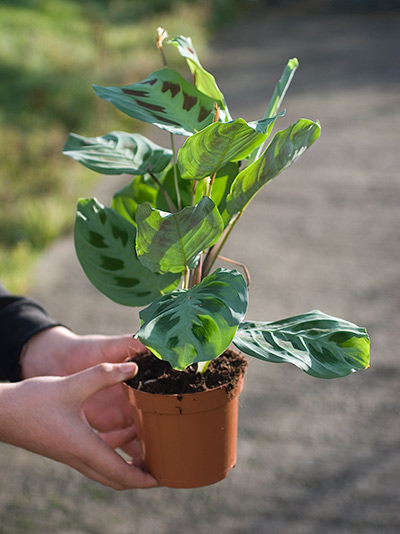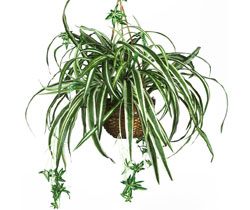Prayer Plant (Maranta leuconeura “Kerchoveana”)

The endearing Prayer Plant hailing from South America is a unique specimen to behold with its distinctive rows of brown to dark-green lines crossing its leaf midribs.
M. leuconeura is a plant that naturally grows low, reaching a maximum height of about 12 inches, and growing outward as it matures.
Prayer Plants like small pots, and their shallow root systems do well in half pots or flat pots. Great for tiny spaces in kitchens or bathrooms!
Why Is it Called a Prayer Plant?
As dusk approaches, the light-green leaves fold upwards, giving the plant the appearance of praying. (Actually, the plant is closing its leaves to conserve moisture.) The Prayer Plant is a great addition to your room or office as a unique conversation piece.
Cloning Your Plants: Propagating Prayer Plant from stem cuttings is the most popular way to share plants. Dip about an inch of your cutting into water, then into a rooting hormone. Place your cutting into your preferred potting medium and watch your baby plant grow. Just remember to keep your potting mix moist.
Prayer Plants are also easy to propagate through division when you repot them in the spring. When repotting, you can divide your prayer plant into several smaller plants by gently shaking the soil off the roots and working them apart.
If you notice your plants are leggy and not as bushy as you’d like, cut them back to the soil line at any time of year, and they will respond with healthy new growth.
Best Place In Your House to Place a Prayer Plant
A small and compact houseplant, the Prayer Plant is ideal for humid kitchen windowsills without any draft, or in any spot that does not fluctuate in temperature too much.
Prayer Plant Care
Light: Prefers semi-sun to semi-shade.
Soil & Air: The Prayer Plant prefers well-drained soil and requires high humidity to thrive. Prayer Plant houseplants should be kept moist, but not soggy. The Prayer Plant has fine, shallow roots that are susceptible to root rot if left in standing water. Make sure its soil and container drain well; water should be able to drain freely from the container’s base, and you’ll be all set.
Pests: If you notice any spider mites or mealybugs, the culprit is likely an environment that is too dry for the Prayer Plant.
During the growing season in spring to summer, keep the soil evenly moist. Do NOT allow the soil to dry between waterings. Feed every two weeks during the growing season. Water sparingly in the winter. Mist often and snap off the old, poor-looking leaves.
A happy Prayer Plant will cyclically open its leaves in the daytime and fold them up over the night.
Prayer Plant Problems & Solutions
If your Prayer Plant isn’t thick and bushy as you’d like, prune your plant in order to regrow its pleasant, bushy appearance. In the fall (or at any time of year, really), cut back the older leaves to the soil line. Use sharp, clean pruning shears disinfected between cuts with a rag dipped in rubbing alcohol.
Prayer Plant Leaves Are Wilting or Dying
Prayer plants exposed to dry, indoor air may react by shriveling or wilting their leaves. Because the plants thrive in high humidity, consider getting a humidifier for that room, placing the plant in a more humid location, or place your plant on a tray of pebbles and pour water into the tray until just below the pot’s drainage holes.
Revive a Limp, Pale or Yellowing Prayer Plant
If your plant is drooping or getting leggy, try moving it into a brighter, west- or south-facing window location. You may be surprised at how much light your Prayer Plant can tolerate.
On the other hand, too much bright lighting or excessive phosphate or fluoride can cause leaf tips and margins to burn, leaving a band of yellow tissue between the healthy and dead tissues. Chlorosis [source] is a yellowing of leaf tissue due to a lack of chlorophyll. Possible causes of chlorosis include poor drainage, damaged roots, compacted roots, high alkalinity, and nutrient deficiencies in the plant. Nutrient deficiencies may occur because there is an insufficient amount in the soil or because the roots are injured or the nutrients are not available due to high soil pH.
Brown leaves suggest the plant’s resting spot is too cool or too dry. Make sure your plants are in a humid, well-lit spot in a room of 65 to 75 °F.
